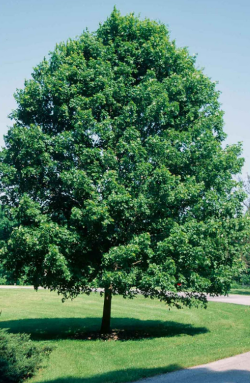
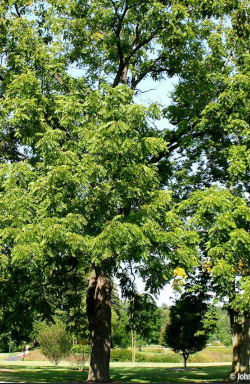
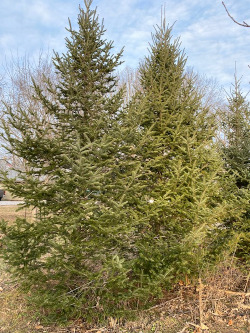
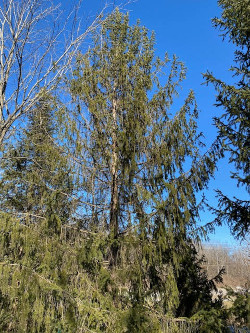
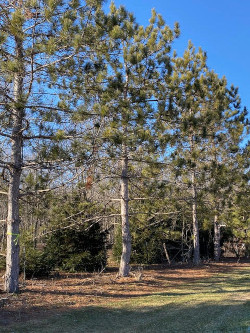
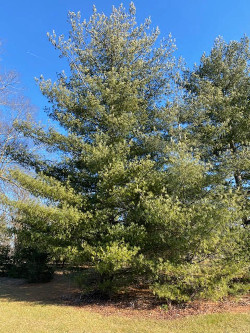
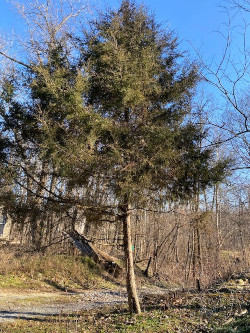
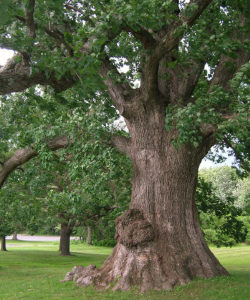
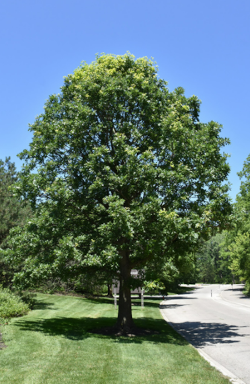
BUR OAK
SCIENTIFIC NAME: Quercus macrocarpa
FAMILY: Fagaceae
ORIGIN: North America
Burr oak performs well in a wide range of soil types including moist soils of bottom lands and also on hill sides. Our forester suggested planting these in both the river bottom acres and along the higher areas we have here. These were planted in November of 2021. The white fence tape and tree protectors you’ll see on the trail will hopefully help us manage deer damage.
For more information: Bur Oak
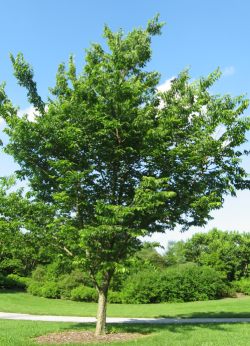
HACKBERRY
SCIENTIFIC NAME: Celtis occidentalis
FAMILY: Cannabaceae
ORIGIN: North America
Hackberry trees are all over this woodland. And while they are not partuculaty valuable trees we don’t choose to discourage them but instead value them if for no other reason than maintaining a wide diversity of tree species here.
Nearly every tree has its place. And the place of the Hackberry is the wooden hoop! Because of its good bending qualities Hackberry was often used for making wooden hoops. And because the wood of the Hackberry looks like the wood from an Ash tree, another name for the Hackberry is Hoop Ash..
For more information: Hackberry
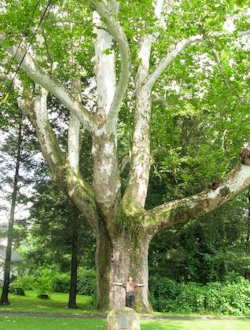
AMERICAN SYCAMORE
SCIENTIFIC NAME: Platanus occidentalis
FAMILY: Platanaceae
ORIGION: Eastern and Central US
You know that song: “And it seems that I can see the gleaming candle light still burning bright through the sycamores for me.” Oh yes. The sycamore…a great (and famous) Indiana tree.
You’ll find Sycamore trees throughout this tree farm. And guess what . . . You may tap Sycamore trees for making syrup! We’ve tried it but did not get any measurable amount of sap. But we’ll probably tray again some day.
For more information: American Sycamore
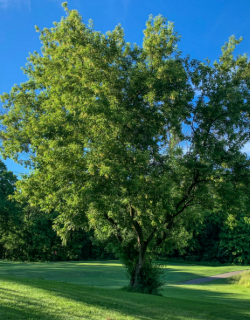
BOXELDER MAPLE
SCIENTIFIC NAME: Acer negundo
FAMILY: Sapindaceae
ORIGION: North America
Want to make some maple syrup…with a twist? This little tree is in the maple family. And yes, people do tap these trees for making maple syrup. We’ve not tried that yet but we may some day.
For more information: Boxelder Maple
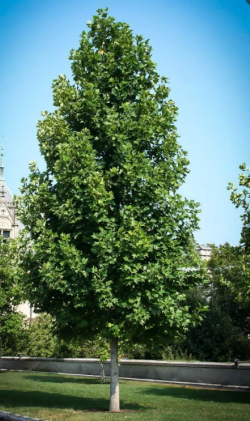
TULIP POPLAR
SCIENTIFIC NAME: Liriodendron tulipifera
FAMILY: Magnoliaceae
ORIGION: North American
This is our state tree! We planted this little tree in the fall of 2021 espcially to dress up our new tree trail. After all, every tree trail in Indiana should have a tulip tree.
Here’s a little know fact: it was the flower of the Tulip Poplar that first got the attention of the Indiana State legislature. It was actually Indiana’s first state flower…but the act making it our state flower was repealed and the tree itself became our state tree by act of legislature in 1931.
For more information: Tuplip Poplar
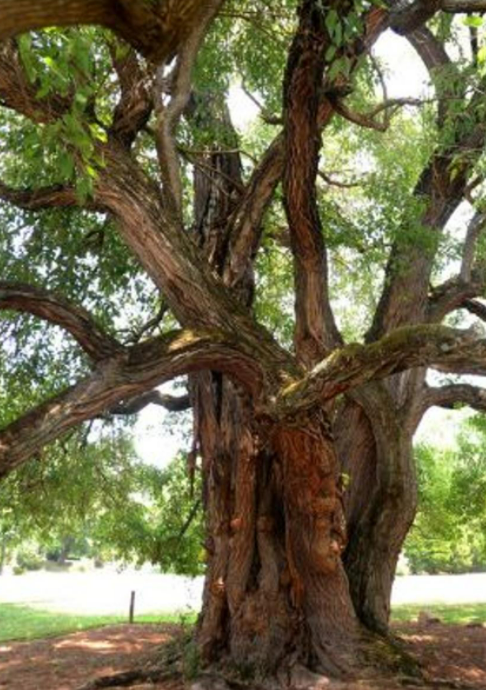
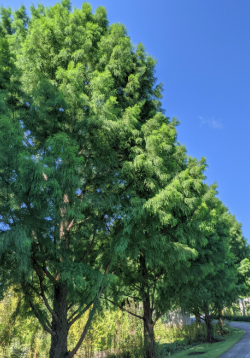
BALD CYPRESS
SCIENTIFIC NAME: Taxodium distichum
FAMILY: Cupressaceae
ORIGIN: Southeastern United States.
Our foresters Mike and Jennifer Warner of Arbor Terra Consulting gave us this tree in 2021. We planted it in a fairly wet area by the pond. Let’s see how it likes it new home.
For more information: Bald Cypress
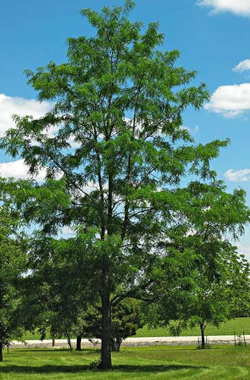
BLACK LOCUST
SCIENTIFIC NAME: Robinia pseudoacacia
FAMILY: Fabaceae
ORIGIN: Eastern and South Eastern United States
Robinia pseudoacacia, known as black locust, provides an early spring bloom that is enjoyed by the Springboro Tree Farms honeybees. As an added bonus ts durability in contact with the ground make it idea for fence posts. We have several posts that have been in the ground since 1992. Look around…you’ll find them.
For more information: Black Locust
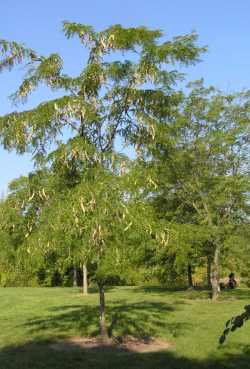
HONEY LOCUST
SCIENTIFIC NAME: Gleditsia triacanthos
FAMILY: Fabaceae
ORIGIN: Central North America
The honey locust, also known as the thorny locust or thorny honeylocust, is native to central North America where it is mostly found in the moist soil of river valleys. These trees are very hard on ATV and tractor tires so we don’t encourage them. You may see a few that we’ve girdled (cut through the bark all the way around the tree with a chain saw) in order to kill the tree. But if the tree is in a location where it can’t cause problems, we let them live.
For more information: Honey Locust.
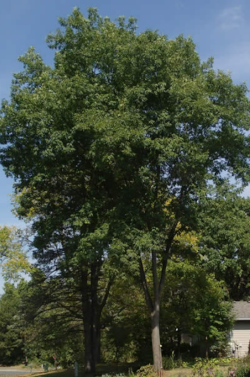
BITTERNUT HICKORY
SCIENTIFIC NAME: Carya cordiformis
FAMILY: Juglandaceae
ORIGIN: Midwestern and Eastern US
Carya cordiformis, the bitternut hickory, also called bitternut or swamp hickory, is a large pecan hickory with commercial stands located mostly north of the other pecan hickories. Bitternut hickory is cut and sold in mixture with the true hickories. One popular use is in the manufacture of split-bottomed chairs…that is, is a chair with a cane or rope-weave seat. Ever sit in an Old Hickory chair? There are a few in the tree house. Check them out.
For more information: Bitternut Hickorya
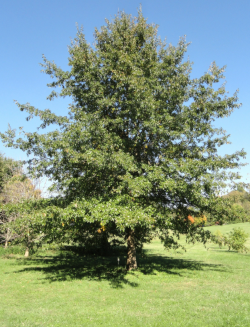
SHINGLE OAK
SCIENTIFIC NAME: Quercus imbricaria
FAMILY: Fagaceae
ORIGIN: Midwestern and Upper South regions of North America
Quercus imbricaria, the shingle oak, is a deciduous tree in the red oak group of oaks. It is native primarily to the Midwestern and Upper South regions of North America, from southern New York west to northern Illinois and eastern Kansas, and south to central Alabama and Arkansas. Shingle oak seems suited for sandy areas (think the sand hills of lake Michigan shore) and prairie soils where other oaks may not grow well. The wood looks like that of the Red Oak but is considered somewhat inferior.
For more information: Shingle Oak
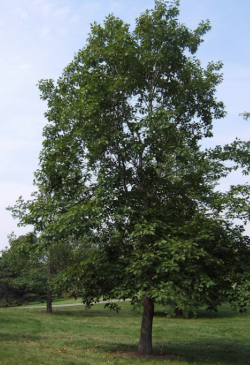
RED OAK
SCIENTIFIC NAME: Quercus rubra
FAMILY: Fagaceae
ORIGIN: North America
Quercus rubra, the northern red oak, is an oak tree in the red oak group. It is a native of North America, in the eastern and central United States and southeast and south-central Canada. Deer must really like the taste of red oak. We planted 15 Red Oak inside a deer protection area and 15 more just outside that area as part of a DNR deer predation research project. The protected trees are doing great but the unprotected trees are practically all destroyed by deer. Check it out. The test site is located near the Apiary just off highway 18.
For more information: Red Oak
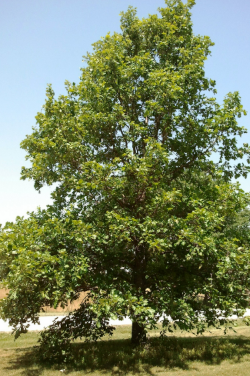
SWAMP WHITE OAK
SCIENTIFIC NAME: Quercus bicolor
FAMILY: Fagaceae
ORIGIN: North American
Quercus bicolor, the swamp white oak, is a North American species of medium-sized trees in the beech family. It is a common element of America’s north central and northeastern mixed forests. It can survive in a variety of habitats. It forms hybrids with bur oak where they occur together in the wild. So, we planted our Swamp Oak along with Burr Oak in our wetter areas in November of 2021. Let’s see how they do. The white fence tape and tree protectors you’ll see on site will hopefully help us manage deer damage.
For more information: Swamp White Oak
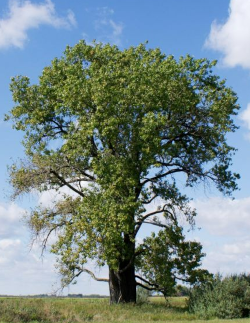
COTTON WOOD
SCIENTIFIC NAME: Populus sect. Aigeiros
FAMILY: Salicaceae
ORIGIN: North America, Europe, and western Asia
Populus section Aigeiros is a section of three species in the genus Populus, the poplars. The species are native to North America, Europe, and western Asia. Here in Indiana in the 1800s and early 1900s the Cottonwood was an important timber tree. And the bark was a favorite of pioneer boys who whittled toys out of it. We have many huge Cottonwood trees here. Check out the tree house (Gentleman’s deer stand) by Spring Creek. It’s supported by Cottonwoods and has one big one that’s growing through its floor and roof!
For more information: Cotton Wood
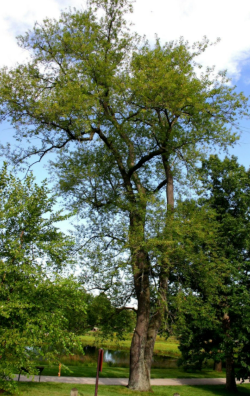
BLACK CHERRY
SCIENTIFIC NAME: Prunus serotina
FAMILY: Rosaceae
ORIGIN: North America
Prunus serotina, commonly called black cherry, wild black cherry, rum cherry, or mountain black cherry, is a deciduous tree or shrub of the genus Prunus. In the fall these trees yield very small cherry fruit. They grow rapidly and get really big. There was one very close to our house that died several years ago. After having it cut down in 2018 I accounted 280 rings in the trunk of the tree but was not able to count all the rings in the center of the trunk because the wood was rotten there. The tree had to be 300+ years old. The stump is still there if you want to see it. Think about it. Tecumseh and his brother the Prophet might have walked past that tree on their way to Prophet’s Town!
For more information: Black Cherry
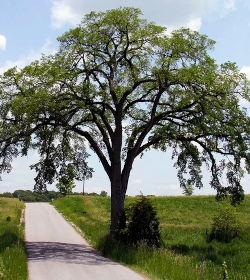
AMERICAN ELM
SCIENTIFIC NAME: Ulmus americana
FAMILY: Ulmaceae
ORIGIN: eastern North America
Ulmus americana, generally known as the American elm or, less commonly, as the white elm or water elm, is a species of elm native to eastern North America, naturally occurring from Nova Scotia west to Alberta and Montana, and south to Florida and central Texas. Here at the farm, we look under and around dying Elm trees in late April and early May in hope of finding Morel mushrooms.
For more information: American Elm
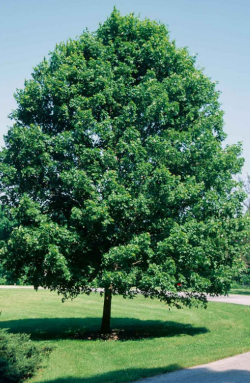
SILVER MAPLE
SCIENTIFIC NAME: Acer saccharinum
FAMILY: Sapindaceae
ORIGIN: Eastern and central United States and southeastern Canada
Acer saccharinum, commonly known as silver maple, creek maple, silverleaf maple, soft maple, large maple, water maple, swamp maple, or white maple, is a species of maple native to the eastern and central United States and southeastern Canada. It is one of the most common trees in the United States. And we have more of them here than we do any other species of tree. The sugar content of Silver Maple is about half that of a Sugar Maple. So while it is possible to tap these trees for making maple syrup, we don’t do it. It just takes too long to boil it down from about ½% – 1% sugar in raw sap to 67% sugar of finished maple syrup.
For more information: Silver Maple
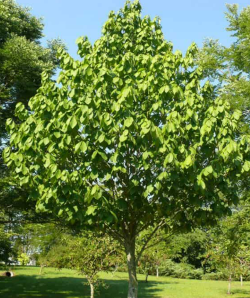
PAW PAW
SCIENTIFIC NAME: Asimina triloba
FAMILY: Annonaceae
ORIGIN: Easter United States
We call it the “Indianan Banana! Asimina triloba, the American papaw, pawpaw, paw paw, or paw-paw, (which ever way you want to spell it), is a small deciduous tree native to the eastern United States and Canada, producing a large, yellowish-green to brown fruit. We’ve not found any fruit yet. Our state district forester James Potthoff tells us that Paw Paws need more sunlight than our location has to produce fruit. So we’ll wait and see.
For more information: Paw Paw
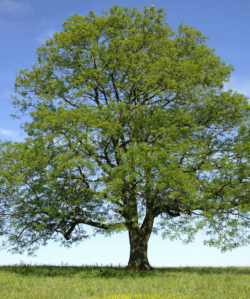
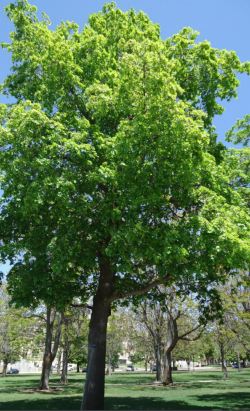
NORWAY MAPLE
SCIENTIFIC NAME: Acer platanoides
FAMILY: Sapindaceae
ORIGIN: Europe and western Asia
This tree is not supposed to be here. It’s technically an “invasive” plant that is not native to Indiana. Acer platanoides, commonly known as the Norway maple, is a species of maple native to eastern and central Europe and western Asia, from Spain east to Russia, north to southern Scandinavia and southeast to northern Iran. It was introduced to North America in the mid-1700s as a shade tree. But we’ll keep it. We’ve tapped these several times for making maple syrup.
For more information: Norway Maple
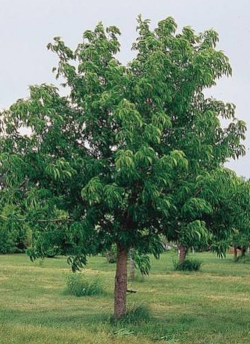
OHIO BUCKEYE
SCIENTIFIC NAME: Aesculus glabra
FAMILY: Sapindaceae
ORIGIN: Midwestern and lower Great Plains regions of the United States
Aesculus glabra, commonly known as Ohio Buckeye, is a species of tree in the soapberry family native to North America. Its natural range is primarily in the Midwestern and lower Great Plains regions of the United States, extending southeast into Alabama and Mississippi. The fruit is poisonous to livestock (though rarely fatal) so in days gone by, farmers often killed these trees.
For more information: Ohio Buckeye
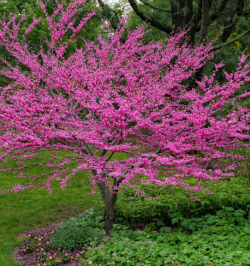
EASTERN REDBUD
SCIENTIFIC NAME: Cercis canadensis
FAMILY: Fabaceae
Cercis canadensis, the Eastern Redbud, is a large deciduous shrub or small tree, native to Indiana and the eastern North America from southern Michigan south to central Mexico, east to New Jersey. Species thrive as far west as California and as far north as southern Ontario. We transplanted several at the entrance to the farm and enjoy the early spring color.
For more information: Eastern Redbud
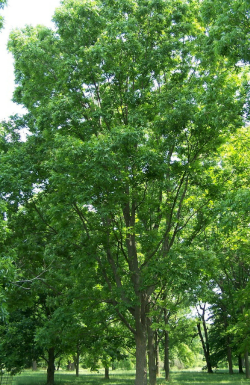
PECAN
SCIENTIFIC NAME: Carya illinoinensis
FAMILY: Juglandaceae
The pecan is a species of hickory that is native to Southern Indiana, the Mississippi River region of the United States and northern Mexico. The tree is cultivated for its seed in the southern United States, primarily in Georgia, New Mexico, Texas, and Mexico. We planted two of them about 2005 as part of our orchard.
For more information: Pecan
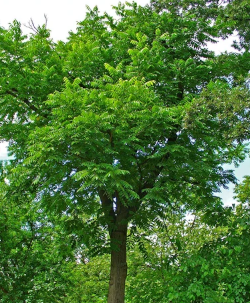
BUTTERNUT
SCIENTIFIC NAME: Juglans cinerea
FAMILY: Juglandaceae
ORIGIN: Eastern US and Southern Canada
Juglans cinerea, commonly known as butternut or white walnut, is a species of walnut native to the eastern United States and southeast Canada. We chose to plant these trees because nearly all the Butternut trees in this part of the world have been killed by butternut canker disease. A fungus causes it. The Butternut trees you see here are a canker disease resistant hybrid purchased from Jasper – Pulaski State nursery in 2005. And yes, we could also tap these butternut trees to make walnut syrup!
For more information: Butternut
